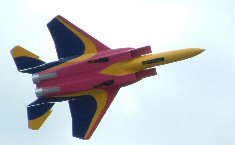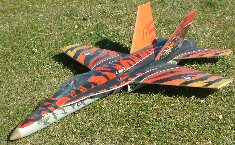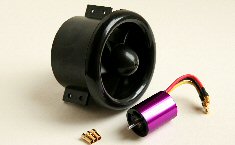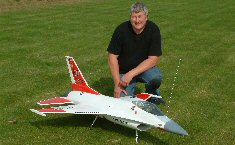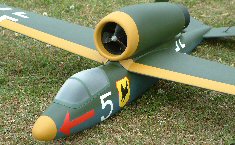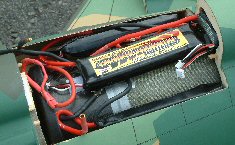|
|||
|
|
|
||
| View Shopping Cart |
| Home |
| Guides Available |
| About the Author |
| FAQs |
| Testimonials |
| Articles |
| Contact Andrew |
| Terms & Conditions |
| Mailing List |
| Links |
 |
 |
Get more great
articles like this one absolutely free with every
Gibbs Guides e-magazine. Join
the mailing list!
Electric Ducted Fan (EDF) Models
Part 1 - Power Systems
Article by Andrew Gibbs
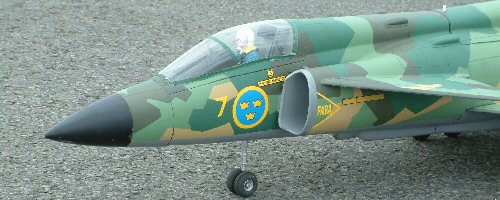
It was not so many years ago that electric ducted fan (EDF) models were a somewhat impractical proposition; whilst they flew, very often they did not have the kind of performance commensurate with their sleek jet appearance. However, brushless motors and lipo batteries completely changed the EDF landscape; now electric jets commonly have a performance entirely in keeping with their appearance.
There are three factors which allowed practical, high performance EDF
models to become an every day reality. These are high power brushless
motors, high performance lipo batteries, plus improvements in both fan
and ducting design. Combined, these factors now allow practical EDF models
to enjoy the sort of phenomenally exciting performance that was unimaginable
only a few years ago.
| This large EDF F15 is the work of Shane Harding (click small images to enlarge). | Superb small EDF Hornet by Nick Butler (click small images to enlarge). |
EDF Power Systems
The power system of an EDF model consists of a small fan or impeller,
driven at high rpm by a suitable brushless electric motor. An ESC and
lipo battery complete the power system, exactly as for a prop driven model.
The fan is supplied with air via suitable ducting, and the exhaust air is ducted out to the tail pipe. The principle of the fan is exactly the same as for a propeller driven model; the fan 'sucks' air in, and expels it at high speed, the result being that the model is propelled forward.
EDF Power Loading
The high revving small fan or impeller of EDF models can never be as efficient
as a larger propeller rotating at a lower speed, so the inefficiencies
inherent in EDF models have to be compensated for by providing for considerably
more input power than might be used with a prop driven model. A power
loading (power to weight ratio) of 100 Watts a pound will generally provide
a sprightly performance to any propeller driven sport model, but this
would not usually be enough to endow an EDF model with decent performance.
Note that the quality of the ducting can make a big difference to the
performance of a model. A model with, say 150W/lb and well designed ducting
may actually have a substantially better performance that an otherwise
identical model with 200W/lb but badly designed ducting.
| A typical EDF small fan. This one is a 70mm unit (click small images to enlarge). | The fan unit in this large F16 draws 4,000 Watts from its 12S lipo (click small images to enlarge) |
| Delightful small EDF Salamander (click small images to enlarge). | Batteries for EDF models are often split into several packs in order to accommodate them within the available space (click small images to enlarge) |
Fan unit - general
The heart of any EDF model is its motor and fan. The size of a fan unit
is specified in terms of their internal diameter. There are a wide variety
of fan units available in many sizes from tiny 25mm units up to 126mm
or more. The most common classes of fan are probably 70mm, 90mm and 120mm.
Motors for EDF- general
Because of the fan’s requirement to rotate very fast, unlike most
propeller driven models, the EDF variety invariably use a high power,
high Kv brushless motor, i.e. a motor that is designed to turn at high
rpm for reach volt applied to it. Since motors are buried deep inside
the model, the high reliability and lack of maintenance of brushless motors
makes them ideal candidates for EDF work.
In contrast to propeller driven models, high Kv outrunner motors are only occasionally found in EDF models for which high Kv inrunner types are usually a much better match with the requirements of the fan.
Choosing an EDF power system
Choosing an EDF power system is a more straightforward process than for
a propeller driven model. Here’s an overview of how to go about
the process:
First, the physical size of the fan needs to be determined. Usually this will be dictated by the design of the model’s ducting, which will be made to suit a particular size of fan. It may even be made to suit a particular, specific fan. So, usually there’s no decision to be made in this respect.
The next decision concerns the amount of power required. With EDF models it’s generally a question of more is better. However, very high power systems can be very expensive, so the question of budget also needs to be addressed. A reasonable level of performance can usually be arranged for relatively modest outlay.
As it is hard to change an EDF power system once it’s installed, I recommend choosing a system with plenty of power from the outset - you can always throttle back if you need less power. To specify a system, find seller’s test figures for power consumption with a particular combination of motor, fan and cells.
Coming back to the question of power loading, a figure of 150W/lb is a good starting point for reasonable performance. As an example, if I had a 2Lb model requiring a 70mm fan, I’d probably start by looking for a 300 Watt system (2lb x 150W/lb = 300 W). If I wanted higher performance, a 400W or higher system would be on my shopping list.
It’s then a question of searching seller’s website information for data about specific fan, motor and battery combinations which will satisfy this level of power. Learn more about EDF power systems here
